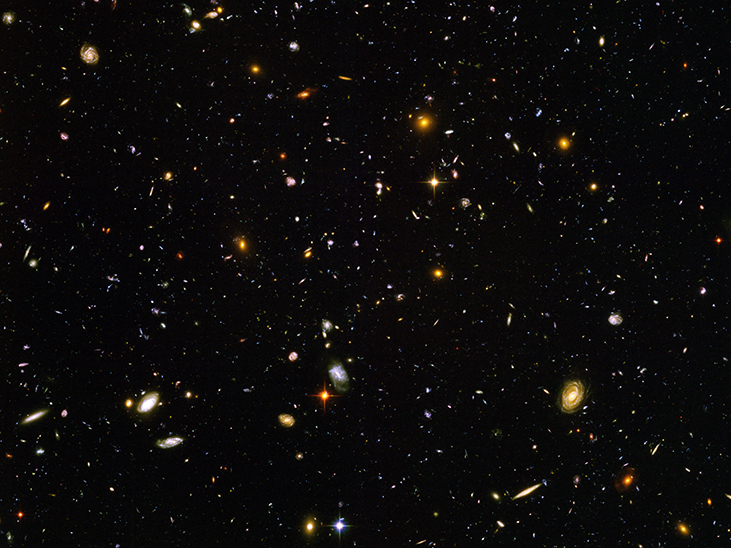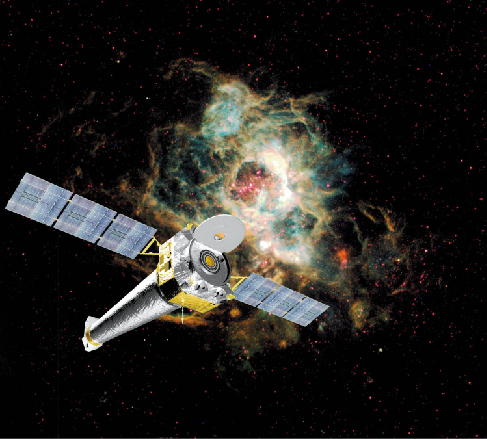| << Chapter < Page | Chapter >> Page > |

The HST’s mirror was ground and polished to a remarkable degree of accuracy. If we were to scale up its 2.4-meter mirror to the size of the entire continental United States, there would be no hill or valley larger than about 6 centimeters in its smooth surface. Unfortunately, after it was launched, scientists discovered that the primary mirror had a slight error in its shape, equal to roughly 1/50 the width of a human hair. Small as that sounds, it was enough to ensure that much of the light entering the telescope did not come to a clear focus and that all the images were blurry. (In a misplaced effort to save money, a complete test of the optical system had not been carried out before launch, so the error was not discovered until HST was in orbit.)
The solution was to do something very similar to what we do for astronomy students with blurry vision: put corrective optics in front of their eyes. In December 1993, in one of the most exciting and difficult space missions ever flown, astronauts captured the orbiting telescope and brought it back into the shuttle payload bay. There they installed a package containing compensating optics as well as a new, improved camera before releasing HST back into orbit. The telescope now works as it was intended to, and further missions to it were able to install even more advanced instruments to take advantage of its capabilities.
Ultraviolet, X-ray, and direct gamma-ray (high-energy electromagnetic wave) observations can be made only from space. Such observations first became possible in 1946, with V2 rockets captured from Germany after World War II. The US Naval Research Laboratory put instruments on these rockets for a series of pioneering flights, used initially to detect ultraviolet radiation from the Sun. Since then, many other rockets have been launched to make X-ray and ultraviolet observations of the Sun, and later of other celestial objects.
Beginning in the 1960s, a steady stream of high-energy observatories has been launched into orbit to reveal and explore the universe at short wavelengths. Among recent X-ray telescopes is the Chandra X-ray Observatory, which was launched in 1999 ( [link] ). It is producing X-ray images with unprecedented resolution and sensitivity. Designing instruments that can collect and focus energetic radiation like X-rays and gamma rays is an enormous technological challenge. The 2002 Nobel Prize in physics was awarded to Riccardo Giacconi , a pioneer in the field of building and launching sophisticated X-ray instruments. In 2008, NASA launched the Fermi Gamma-ray Space Telescope, designed to measure cosmic gamma rays at energies greater than any previous telescope, and thus able to collect radiation from some of the most energetic events in the universe.

One major challenge is to design “mirrors” to reflect such penetrating radiation as X-rays and gamma rays, which normally pass straight through matter. However, although the technical details of design are more complicated, the three basic components of an observing system, as we explained earlier in this chapter, are the same at all wavelengths: a telescope to gather up the radiation, filters or instruments to sort the radiation according to wavelength, and some method of detecting and making a permanent record of the observations. [link] lists some of the most important active space observatories that humanity has launched.
Gamma-ray detections can also be made from Earth’s surface by using the atmosphere as the primary detector. When a gamma ray hits our atmosphere, it accelerates charged particles (mostly electrons) in the atmosphere. Those energetic particles hit other particles in the atmosphere and give off their own radiation. The effect is a cascade of light and energy that can be detected on the ground. The VERITAS array in Arizona and the H.E.S.S. array in Namibia are two such ground-based gamma-ray observatories.
| Recent Observatories in Space | ||||
|---|---|---|---|---|
| Observatory | Date Operation Began | Bands of the Spectrum | Notes | Website |
| Hubble Space Telescope (HST) | 1990 | visible, UV, IR | 2.4-m mirror; images and spectra | www.hubblesite.org |
| Chandra X-Ray Observatory | 1999 | X-rays | X-ray images and spectra | www.chandra.si.edu |
| XMM-Newton | 1999 | X-rays | X-ray spectroscopy | http://www.cosmos.esa.int/web/xmm-newton |
| International Gamma-Ray Astrophysics Laboratory (INTEGRAL) | 2002 | X- and gamma-rays | higher resolution gamma-ray images | http://sci.esa.int/integral/ |
| Spitzer Space Telescope | 2003 | IR | 0.85-m telescope | www.spitzer.caltech.edu |
| Fermi Gamma-ray Space Telescope | 2008 | gamma-rays | first high-energy gamma-ray observations | fermi.gsfc.nasa.gov |
| Kepler | 2009 | visible-light | planet finder | http://kepler.nasa.gov |
| Wide-field Infrared Survey Explorer (WISE) | 2009 | IR | whole-sky map, asteroid searches | www.nasa.gov/mission_pages/WISE/main |
| Gaia | 2013 | visible-light | Precise map of the Milky Way | http://sci.esa.int/gaia/ |
Infrared observations are made with telescopes aboard aircraft and in space, as well as from ground-based facilities on dry mountain peaks. Ultraviolet, X-ray, and gamma-ray observations must be made from above the atmosphere. Many orbiting observatories have been flown to observe in these bands of the spectrum in the last few decades. The largest-aperture telescope in space is the Hubble Space telescope (HST), the most significant infrared telescope is Spitzer, and Chandra and Fermi are the premier X-ray and gamma-ray observatories, respectively.

Notification Switch
Would you like to follow the 'Astronomy' conversation and receive update notifications?